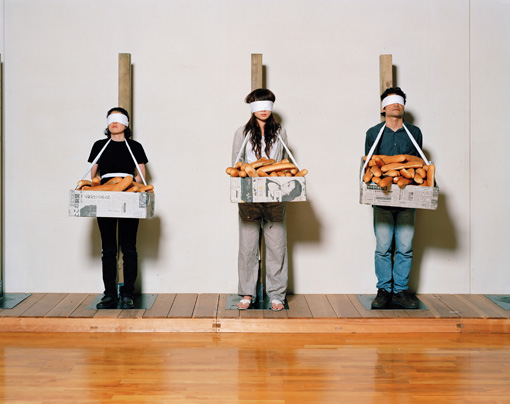
Punishment - When communication is wasted
DNA is proud to present for the first time in Europe Tatsumi Orimoto's Punishment. Following in the footsteps of the artist's "Communication Art", this performance also features bread as its main element. Orimoto often uses bread because of its fundamental and basic nature. However, he does not only use it as a symbol for universal communication - something to which everybody can relate - but also as an allegory for Western culture. In the occidental context bread does not only take on meaning as part of the diet of the population but also because of its symbolism in Christianity, where it represents the body par excellence.
With this background Tatsumi becomes in Breadman a sort of living sculpture, his head twined with a bundle of baguettes, who brings art to the people. Nevertheless, bread and its former mentioned function as a tool for communication take on in Punishment a more tragic nuance. Twenty-six blindfolded people, tied to a mast, are carrying a box full of bread. One after the other, each of them falls over, spilling the bread on the floor.
Tatsumi's performance may be referring to Japanese history. On the 5th of February 1597, during the Azuchi-Momoyama Period, the government crucified 26 Christian missionaries in Nagasaki. At the time, Christian missionaries, who initially had been accepted in Japan in order to restrain the influence of Buddhist monks and to consolidate commercial relationships with Europe, were perceived by Toyotomi Hideyoshi as a destabilizing force and therefore were persecuted. However, Orimoto seeks to disconnect himself from historical references in order to stress the universal and recurrent: the bread bearer, a prophet who carries a different message, is seen as a threat against the establishment and is repudiated and martyred. Thus his message spills, the box is empty, and communication fails. The message, as well as the bread, putrefies.
At the same time Punishment could also refer to Orimoto's private situation, especially to the lack of recognition his works has received in his own country, about which Tatsumi often complains. It is not new that the artist makes from his private issues a public matter. This is most evident in his project Art Mama, through which Tatsumi publicly documents the physical and mental decline of his mother, Odei, who has the Alzeimer disease and whom he takes care of since 1996. Through the bread that stays on the floor in Punishment we are witnesses from another decadence as well: the one from a wasted communication.
Tatsumi Orimoto (Kawasaki, 1946) studied at the Institute of Art, California. In 1971 he moved to New York, where he assisted Nam June Paik and was introduced to Fluxus. He returned to Kawasaki in 1977, where he currently lives and works, and takes care of his mother. His performance Breadman was shown in several countries in public as well as institutional contexts, such as the Biennales of Sydney, Sao Pablo and Venice.
Panel Discussion on 2nd November at 4 pm, Goethe Institut Berlin
The dilemma of collecting art in times of dematerialization
Organized by Galerie DNA
The problem of the object-hood and the dematerialization of artworks became one of the most interesting discussions about art since the 1960's. There were many attempts to dissolve the artwork through performance art, Fluxus and Happenings events, conceptual art, till the present, the works of Tino Sehgal being the most radical example. Behind each of them there was a different motivation: the overcoming of the lifelessness of the object through process orientated works; the elimination of the distance between art and life; the critic of the artwork as a commercial good or a critic against our economic production system.
During the seventies critics predicted the disappearance of the art object, which never completely took place because in every artwork something is been materialized. Indeed all these attempts result in the expansion of the concept of object-hood and the reduction in the materiality of the artworks, not only through the previously mentioned attempts but also because of the use of so-called new media.
The art market for its part also tried to absorb these artworks in their dematerialized state. The most remarkable example could be This is good from Tino Sehgal, which was bought by Museum Ludwig and from which there is no physical trace.
DNA invites several experts from the art scene to discuss about collecting dematerialized artworks. How can art institutions adapt their structure in order to assimilate these artworks through means other than photography, certifications or documents, when they interact within the context of fine arts which is essentially orientated to objects? When a museum, as a social value creator, prefers for example the documentation of a performance instead of the performance itself, it takes a clear position about the object-hood of an artwork. This position is derived from the idea that an artwork is always related to a physical object. Is it possible for a museum to extend the structure of its collection, so it can also secure the permanence of these dematerialized artworks and in doing so still fulfill its function? Can the introduction of a special section for performance in the program of different art fairs like ARCO or ArtBasel lead to the commercialization of the performance itself and not only its photographical or filmic documentation?
Cynthia Goodman (curator), Mark Gisbourne (curator, art critic), Jan Hoet (artistic director from MARTa Herford), Fumio Nanjo (artistic director from Mori Museum, Tokio), Berta Sichel (Director of the Department of Audiovisuals and Film and Video Curator, Museo Nacional Centro de Arte Reina Sofia, Spain) and Mark Waugh (curator) are invited on November, 2nd to argue about these questions.
2nd November 2008 at 4 pm
Goethe Institut Berlin, Neue Schönhauser Str. 20, 10178 Berlin

